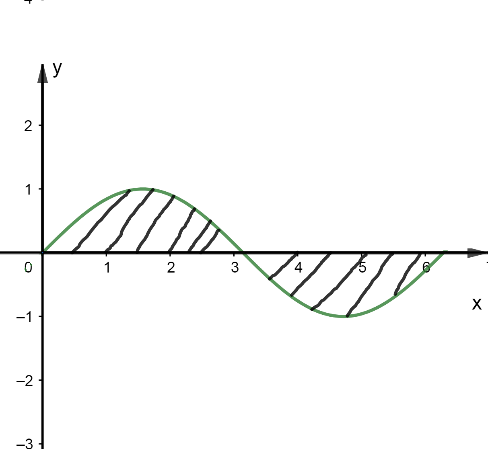
The maximum value of $4{{\sin }^{2}}x-12\sin x+7$ is.
A. 25
B. 4
C. Does not exist
D. None of these
Answer
608.4k+ views
Hint: We know that the value of $\sin \theta $ varies from – 1 to 1. So, from this concept we will try to find the maximum value of the given equation.
Complete step-by-step Solution:
It is given in the question that we have to find the maximum value of,
$\Rightarrow 4{{\sin }^{2}}x-12\sin x+7$
Taking 4 common from $4{{\sin }^{2}}x-12\sin x$, we get,
$\Rightarrow 4\left( {{\sin }^{2}}x-3\sin x \right)+7$
Now, we will add and subtract ${{\left( \dfrac{3}{2} \right)}^{2}}$ and also multiply and divide the term $3\sin x$ by 2. So, we will get,
$\Rightarrow 4\left[ {{\sin }^{2}}x-2.\sin x.\dfrac{3}{2}+{{\left( \dfrac{3}{2} \right)}^{2}}-{{\left( \dfrac{3}{2} \right)}^{2}} \right]+7$
Since we know that ${{\left( a+b \right)}^{2}}={{a}^{2}}+2ab+{{b}^{2}}$ , we write the above equation as,
$\Rightarrow 4\left[ {{\left( \sin x-\dfrac{3}{2} \right)}^{2}}-\dfrac{9}{4} \right]+7$
On opening the bracket and multiplying the terms inside the bracket with 4, we get,
$\begin{align}
& \Rightarrow 4{{\left( \sin x-\dfrac{3}{2} \right)}^{2}}-\dfrac{9}{4}\times 4+7 \\
& \Rightarrow 4{{\left( \sin x-\dfrac{3}{2} \right)}^{2}}-9+7 \\
& \Rightarrow 4{{\left( \sin x-\dfrac{3}{2} \right)}^{2}}-2 \\
\end{align}$
We know that, the value of sin varies from – 1 to 1
$\Rightarrow -1\le \sin x\le 1..........\left( 1 \right)$

(Graph of sinx)
Subtracting $\dfrac{3}{2}$ from all sides in equation (1), we get,
$\begin{align}
& \Rightarrow -1-\dfrac{3}{2}\le \left( \sin x-\dfrac{3}{2} \right)\le +1-\dfrac{3}{2} \\
& or \\
& \Rightarrow \dfrac{-5}{2}\le \left( \sin x-\dfrac{3}{2} \right)\le \dfrac{-1}{2} \\
\end{align}$
On squaring all sides fraction sign changes, we get,
$\Rightarrow \dfrac{1}{4}\le {{\left( \sin x-\dfrac{3}{2} \right)}^{2}}\le \dfrac{25}{4}$
On multiplying the above expression by 4, we get,
$\Rightarrow 1\le 4{{\left( \sin x-\dfrac{3}{2} \right)}^{2}}\le 25$
Subtracting 2 from all sides, we get,
$\begin{align}
& \Rightarrow 1-2\le 4{{\left( \sin x-\dfrac{3}{2} \right)}^{2}}-2\le 25-2 \\
& \Rightarrow -1\le 4{{\left( \sin x-\dfrac{3}{2} \right)}^{2}}-2\le 23 \\
\end{align}$
Hence, the maximum value of $\left[ 4{{\left( \sin x-\dfrac{3}{2} \right)}^{2}}-2 \right]\ \ is\ \ 23$.
Or the maximum value of $4{{\sin }^{2}}x-12\sin x+7$ is 23.
Therefore option (D) is the correct answer.
Note: This question can be solved in just a few steps. You just need to memorise the graph of sin x and keeping limits of sin in mind to solve this problem. This will save your time.
One mistake that can be committed is by not changing the inequality sign and getting the wrong result.
Complete step-by-step Solution:
It is given in the question that we have to find the maximum value of,
$\Rightarrow 4{{\sin }^{2}}x-12\sin x+7$
Taking 4 common from $4{{\sin }^{2}}x-12\sin x$, we get,
$\Rightarrow 4\left( {{\sin }^{2}}x-3\sin x \right)+7$
Now, we will add and subtract ${{\left( \dfrac{3}{2} \right)}^{2}}$ and also multiply and divide the term $3\sin x$ by 2. So, we will get,
$\Rightarrow 4\left[ {{\sin }^{2}}x-2.\sin x.\dfrac{3}{2}+{{\left( \dfrac{3}{2} \right)}^{2}}-{{\left( \dfrac{3}{2} \right)}^{2}} \right]+7$
Since we know that ${{\left( a+b \right)}^{2}}={{a}^{2}}+2ab+{{b}^{2}}$ , we write the above equation as,
$\Rightarrow 4\left[ {{\left( \sin x-\dfrac{3}{2} \right)}^{2}}-\dfrac{9}{4} \right]+7$
On opening the bracket and multiplying the terms inside the bracket with 4, we get,
$\begin{align}
& \Rightarrow 4{{\left( \sin x-\dfrac{3}{2} \right)}^{2}}-\dfrac{9}{4}\times 4+7 \\
& \Rightarrow 4{{\left( \sin x-\dfrac{3}{2} \right)}^{2}}-9+7 \\
& \Rightarrow 4{{\left( \sin x-\dfrac{3}{2} \right)}^{2}}-2 \\
\end{align}$
We know that, the value of sin varies from – 1 to 1
$\Rightarrow -1\le \sin x\le 1..........\left( 1 \right)$

(Graph of sinx)
Subtracting $\dfrac{3}{2}$ from all sides in equation (1), we get,
$\begin{align}
& \Rightarrow -1-\dfrac{3}{2}\le \left( \sin x-\dfrac{3}{2} \right)\le +1-\dfrac{3}{2} \\
& or \\
& \Rightarrow \dfrac{-5}{2}\le \left( \sin x-\dfrac{3}{2} \right)\le \dfrac{-1}{2} \\
\end{align}$
On squaring all sides fraction sign changes, we get,
$\Rightarrow \dfrac{1}{4}\le {{\left( \sin x-\dfrac{3}{2} \right)}^{2}}\le \dfrac{25}{4}$
On multiplying the above expression by 4, we get,
$\Rightarrow 1\le 4{{\left( \sin x-\dfrac{3}{2} \right)}^{2}}\le 25$
Subtracting 2 from all sides, we get,
$\begin{align}
& \Rightarrow 1-2\le 4{{\left( \sin x-\dfrac{3}{2} \right)}^{2}}-2\le 25-2 \\
& \Rightarrow -1\le 4{{\left( \sin x-\dfrac{3}{2} \right)}^{2}}-2\le 23 \\
\end{align}$
Hence, the maximum value of $\left[ 4{{\left( \sin x-\dfrac{3}{2} \right)}^{2}}-2 \right]\ \ is\ \ 23$.
Or the maximum value of $4{{\sin }^{2}}x-12\sin x+7$ is 23.
Therefore option (D) is the correct answer.
Note: This question can be solved in just a few steps. You just need to memorise the graph of sin x and keeping limits of sin in mind to solve this problem. This will save your time.
One mistake that can be committed is by not changing the inequality sign and getting the wrong result.
Recently Updated Pages
Why are manures considered better than fertilizers class 11 biology CBSE

Find the coordinates of the midpoint of the line segment class 11 maths CBSE

Distinguish between static friction limiting friction class 11 physics CBSE

The Chairman of the constituent Assembly was A Jawaharlal class 11 social science CBSE

The first National Commission on Labour NCL submitted class 11 social science CBSE

Number of all subshell of n + l 7 is A 4 B 5 C 6 D class 11 chemistry CBSE

Trending doubts
Differentiate between an exothermic and an endothermic class 11 chemistry CBSE

10 examples of friction in our daily life

One Metric ton is equal to kg A 10000 B 1000 C 100 class 11 physics CBSE

Difference Between Prokaryotic Cells and Eukaryotic Cells

1 Quintal is equal to a 110 kg b 10 kg c 100kg d 1000 class 11 physics CBSE

State the laws of reflection of light




